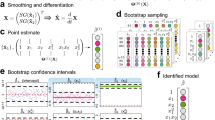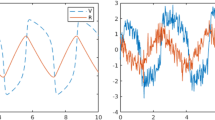Abstract
Many real-world scientific and engineering processes are governed by complex nonlinear interactions, and differential equations are commonly used to explain the dynamics of these complex systems. While the differential equations generally capture the dynamics of the system, they impose a rigid modeling structure that assumes the dynamics of the system are known. Even when some of the dynamical relationships are known, rarely do we know the form of the governing equations. Learning these governing equations can improve our understanding of the mechanisms driving the complex systems. Here, we present a Bayesian data-driven approach to nonlinear dynamic equation discovery. The Bayesian framework can accommodate measurement noise and missing data, which are common in these systems, and accounts for model parameter uncertainty. We illustrate our method using simulated data as well as three real-world applications for which dynamic equations are used to study real-world processes.
Supplementary materials accompanying this paper appear online.


Similar content being viewed by others
References
Barnston AG, Glantz MH, He Y (1999) Predictive skill of statistical and dynamical climate models in SST forecasts during the 1997–98 El Niño episode and the 1998 La Niña onset. Bull Am Meteor Soc 80(2):217–244
Berliner LM (1996) Hierarchical Bayesian time series models. Maximum Entropy and Bayesian Methods. Springer, Netherlands, Dordrecht, pp 15–22
Berliner LM (2003) Physical-statistical modeling in geophysics. J Geophys Res: Atmospheres, 108(D24)
Bezanson J, Edelman A, Karpinski S, Shah VB (2017) Julia: A fresh approach to numerical computing. SIAM Rev 59(1):65–98
Bongard J, Lipson H (2007) Automated reverse engineering of nonlinear dynamical systems. Proc Natl Acad Sci 104(24):9943–9948
Boninsegna L, Nüske F, Clementi C (2018) Sparse learning of stochastic dynamical equations. J Chem Phys 148(24):241723
Both G-J, Choudhury S, Sens P, Kusters R (2021) DeepMoD: Deep learning for model discovery in noisy data. J Comput Phys 428(1):109985
Brunton SL, Proctor JL, Kutz JN (2016) Discovering governing equations from data by sparse identification of nonlinear dynamical systems. Proc Natl Acad Sci 113(15):3932–3937
Bulmer MG (1974) A statistical analysis of the 10-year cycle in Canada. J Anim Ecol 43(3):701–718
Champion K, Zheng P, Aravkin AY, Brunton SL, Kutz JN (2020) A unified sparse optimization framework to learn parsimonious physics-informed models from data. IEEE Access 8:169259–169271
Chartrand R (2011) Numerical differentiation of noisy, nonsmooth data. ISRN Appl Math 2011:1–11
Cressie NAC, Wikle CK (2011) Statistics For Spatio-Temporal Data. John Wiley & Sons, US
de Silva B, Champion K, Quade M, Loiseau J-C, Kutz J, Brunton S (2020) PySINDy: A Python package for the sparse identification of nonlinear dynamical systems from data. J Open Source Softw 5(49):2104
Elton C, Nicholson M (1942) The ten-year cycle in numbers of the lynx in Canada. J Anim Ecol 11(2):215–244
Fasel U, Kutz JN, Brunton BW, Brunton SL (2022) Ensemble-sindy: Robust sparse model discovery in the low-data, high-noise limit, with active learning and control. Proceed Royal Soc A 478(2260):20210904
Galioto N, Gorodetsky AA (2020) Bayesian system ID: Optimal management of parameter, model, and measurement uncertainty. Nonlinear Dyn 102(1):241–267
Gauss CF (1809) Theoria motus corporum coelestium in sectionibus conicis solem ambientium
Gelman A (2006) Prior distributions for variance parameters in hierarchical models. Bayesian Anal 1(3):515–533
George EI, McCulloch RE (1993) Variable selection via Gibbs sampling. J Am Stat Assoc 88(423):881–889
George EI, McCulloch RE (1997) Approaches for Bayesian variable selection. Stat Sin 7(2):339–373
George EI, Sun D, Ni S (2008) Bayesian stochastic search for VAR model restrictions. J Economet 142(1):553–580
Hewitt E, Hewitt RE (1979) The Gibbs-Wilbraham phenomenon: an episode in Fourier analysis. Arch Hist Exact Sci 21(2):129–160
Higham NJ, Dennis MR, Glendinning P, Martin PA, Santosa F, Tanner J (2016) The Princeton Companion to Applied Mathematics. Princeton University Press, US
Hirsh SM, Barajas-Solano DA, Kutz JN (2021) Sparsifying priors for Bayesian uncertainty quantification in model discovery. arXiv preprint arXiv:2107.02107, pages 1–22
Hooten MB, Wikle CK (2008) A hierarchical Bayesian non-linear spatio-temporal model for the spread of invasive species with application to the Eurasian Collared-Dove. Environ Ecol Stat 15(1):59–70
Huang A, Wand MP (2013) Simple marginally noninformative prior distributions for covariance matrices. Bayesian Anal 8(2):439–452
Huang B, Thorne PW, Banzon VF, Boyer T, Chepurin G, Lawrimore JH, Menne MJ, Smith TM, Vose RS, Zhang H-M (2017) Extended reconstructed sea surface temperature, version 5 (ersstv5): upgrades, validations, and intercomparisons. J Clim 30(20):8179–8205
Krebs CJ, Boonstra R, Boutin S, Sinclair AR (2001) What drives the 10-year cycle of snowshoe hares? Bioscience 51(1):25–35
Kuhnert PM (2017) Physical-Statistical Modeling. In: Wiley StatsRef: Statistics Reference Online, pp. 1–5. Wiley
Legendre AM (1806) Nouvelles méthodes pour la détermination des orbites des cometes. F. Didot
Li Q, Lin N (2010) The Bayesian elastic net. Bayesian. Analysis 5(1):151–170
Long Z, Lu Y, Dong B (2019) PDE-Net 2.0: Learning PDEs from data with a numeric-symbolic hybrid deep network. J Comput Phys 399:108925
Long Z, Lu Y, Ma X, and Dong B (2017) PDE-Net: Learning PDEs from data. 35th International Conference on Machine Learning, ICML 2018, 7:5067–5078
Lorenz EN (1963) Deterministic nonperiodic flow. J Atmos Sci 20(2):130–141
Lotka AJ (1920) Analytical note on certain rhythmic relations in organic systems. Proc Natl Acad Sci 6(7):410–415
Mandt S, Hoffman M, Blei D (2016) A variational analysis of stochastic gradient algorithms. Proceedings of The 33rd International Conference on Machine Learning, 48:354–363
Milliff RF, Bonazzi A, Wikle CK, Pinardi N, Berliner LM (2011) Ocean ensemble forecasting. Part I: Ensemble Mediterranean winds from a Bayesian hierarchical model. Q J R Meteorol Soc 137(657):858–878
Niven R, Mohammad-Djafari A, Cordier L, Abel M, Quade M (2020) Bayesian identification of dynamical systems. Proceedings 33(1):33
Philander S (1990) El Niño, La Niña, and the Southern Oscillation. Academic Press, Cambridge
Raissi M, Karniadakis GE (2018) Hidden physics models: machine learning of nonlinear partial differential equations. J Comput Phys 357:125–141
Raissi M, Perdikaris P, Karniadakis GE (2017) Physics informed deep learning (Part I): Data-driven solutions of nonlinear partial differential equations. ArXiv, pp. 1–22
Raissi M, Perdikaris P, Karniadakis GE (2019) Physics-informed neural networks: a deep learning framework for solving forward and inverse problems involving nonlinear partial differential equations. J Comput Phys 378:686–707
Raissi M, Yazdani A, Karniadakis GE (2020) Hidden fluid mechanics: learning velocity and pressure fields from flow visualizations. Science 367(6481):1026–1030
Ramsay JO, Silverman BW (2005) Functional Data Anal. Springer Series in Statistics, Springer, New York, New York, NY
Revels J, Lubin M, Papamarkou T (2016) Forward-mode automatic differentiation in Julia. ArXiv
Royle JA, Berliner LM, Wikle CK, Milliff R (1999) A hierarchical spatial model for constructing wind fields from scatterometer data in the Labrador Sea. In: Case Studies in Bayesian Statistics., pp. 367–382. Springer, New York, NY
Rudy SH, Alla A, Brunton SL, Kutz JN (2019) Data-driven identification of parametric partial differential equations. SIAM J Appl Dyn Syst 18(2):643–660
Rudy SH, Brunton SL, Proctor JL, Kutz JN (2017) Data-driven discovery of partial differential equations. Sci Adv 3(4):e1602614
Schmidt M, Lipson H (2009) Distilling free-form natural laws from experimental data. Science 324(5923):81–85
Shumway RH Stoffer DS (2017) Time series analysis and its applications with R examples. Springer, 4 edition
Sun Y, Zhang L, Schaeffer H (2019) NeuPDE: Neural network based ordinary and partial differential equations for modeling time-dependent data. arXiv preprint arXiv:1908.03190, 107(2016):352–372
van Oldenborgh GJ, Balmaseda MA, Ferranti L, Stockdale TN, Anderson DL (2005) Did the ECMWF seasonal forecast model outperform statistical ENSO forecast models over the last 15 years? J Clim 18(16):3240–3249
Wang JL, Chiou JM, Müller HG (2016) Functional data analysis. Ann Rev Statistics and Its Appl 3:257–295
Wikle CK (2003) Hierarchical Bayesian models for predicting the spread of ecological processes. Ecology 84(6):1382–1394
Wikle CK, Holan SH (2011) Polynomial nonlinear spatio-temporal integro-difference equation models. J Time Ser Anal 32(4):339–350
Wikle CK, Milliff RF, Nychka D, Berliner LM (2001) Spatiotemporal hierarchical bayesian modeling tropical ocean surface winds. J Am Stat Assoc 96(454):382–397
Wu K, Xiu D (2020) Data-driven deep learning of partial differential equations in modal space. J Comput Phys 408:109307
Xu H, Zhang D, Zeng J (2021) Deep-learning of parametric partial differential equations from sparse and noisy data. Phys Fluids 33(3):037132
Yang Y, Aziz Bhouri M, Perdikaris P (2020) Bayesian differential programming for robust systems identification under uncertainty. Proceed Royal Soc A: math Phys Eng Sci 476(2243):20200290
Zhang S, Lin G (2018) Robust data-driven discovery of governing physical laws with error bars. Proceed Royal Soc A: Math, Phys Eng Sci 474(2217):20180305
Zhang Z, Tao Y, Li Z (2007) Factors affecting hare-lynx dynamics in the classic time series of the Hudson Bay Company Canada. Climate Res 34(2):83–89
Zheng P, Askham T, Brunton SL, Kutz JN, Aravkin AY (2019) A unified framework for sparse relaxed regularized regression: SR3. IEEE Access 7:1404–1423
Author information
Authors and Affiliations
Corresponding author
Ethics declarations
Conflict of interest
Authors declare that they have no competing interests.
Data available
The data and materials associated with this manuscript are available on GitHub at https://github.com/jsnowynorth/DEtection.jl
Additional information
Publisher's Note
Springer Nature remains neutral with regard to jurisdictional claims in published maps and institutional affiliations.
Supplementary Information
Below is the link to the electronic supplementary material.
Rights and permissions
Springer Nature or its licensor holds exclusive rights to this article under a publishing agreement with the author(s) or other rightsholder(s); author self-archiving of the accepted manuscript version of this article is solely governed by the terms of such publishing agreement and applicable law.
About this article
Cite this article
North, J.S., Wikle, C.K. & Schliep, E.M. A Bayesian Approach for Data-Driven Dynamic Equation Discovery. JABES 27, 728–747 (2022). https://doi.org/10.1007/s13253-022-00514-1
Received:
Revised:
Accepted:
Published:
Issue Date:
DOI: https://doi.org/10.1007/s13253-022-00514-1




